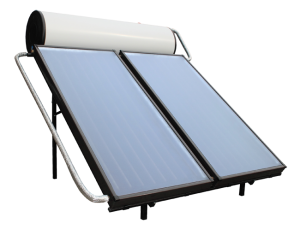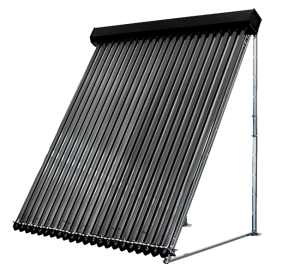Install a solar hot water system
For many businesses, solar hot water systems can reduce their hot water bills by hundreds of dollars every year. With larger systems, it can save thousands of dollars.
When you mention solar hot water, many people think of the small traditional household solar hot water system. However, with solar hot water systems you can go as large as you like.
De Bortoli Winery has a 3,000 Apricus evacuated tube solar hot system that can preheat up to 12,000 litres of water.[1] This huge set-up makes it the largest solar hot water system at a winery in Australasia.
If you aren’t using a solar hot water system, you should check out how much they could save your business. The bigger your solar hot water system, the bigger your savings can be.
- According to Sustainability Victoria, solar hot water can reduce hot water bills by up to 75%.[2]
- When getting a solar hot water system, a gas-boosted system is currently cheaper to run than one that’s boosted by electricity. However, with increases in gas prices, this may change. In remote areas, LPG gas can also be used to boost your solar hot water system, but this can be more expensive still.
Why should you have electric or gas to back your solar hot water system?
During a period of cloudy or overcast weather, having the electric or gas booster attached to your solar hot water system can guarantee you’ll get hot water.
When it’s cloudy, it’s handy to have this booster on hand. However, during the summer period, you will rarely need this back-up.
If you have an electric-boosted solar hot water system, check with your energy retailer to see if you can connect it to an off-peak electricity plan.
What is solar thermal technology?
The first solar hot water system was used in Australia in 1941. This technology is primarily used to heat household hot water, but it can also be used by businesses too.
In 2015 there were 737,307 solar hot water systems[3] in operation in Australia, so you won’t be alone if you make the switch.
Department of Industry and Science has a useful guide for people who want to switch to solar hot water heaters – you can check it out here: EnergyCut.info/solar-water-heat-guide
Alice Springs Veterinary Hospital, NT
Alice Springs Veterinary Hospital installed a solar hot water system with a circulating pump, so there is no wait time to get hot water from the pipes. This saves on energy costs and reduces water waste and inconvenience.[4]
Advice for purchasing and installing solar hot water systems
When you decide to get a solar hot water system, check with your local retailer/installer for details of any government incentives that will help you to make the switch.
Then shop around for two or more quotes. Ask the solar hot water retailers to identify any government incentives and grants that are included in their quotes.
A retailer or installer will need to take the following into consideration when giving you a quote::
- how much hot water you use (this will dictate the size of the system you need)
- whether you have enough roof space
- whether your roof can support the system you need
- whether the orientation of your roof will suit a solar hot water system
- what kind of auxiliary boost you will need
Finally check whether their warranty includes frost protection.
For detailed advice about purchasing a solar hot water system, visit the following:
- Clean Energy Council fact sheet advice for purchasing solar hot water and heat pump systems:
EnergyCut.info/cec-solar-fact
According to Sustainability Victoria, solar hot water can reduce hot water bills by up to 75%. [5]
What type of solar hot water systems exist?
The EnergyRating.gov.au website has the following advice regarding the two different types of solar hot water systems.[6]
Flat plate panels
 Flat plate panels have been used for around 40 years and are common around Australia. They operate at maximum efficiency when the sun is directly overhead at midday but are less efficient at other times of the day when the sun’s rays hit the panels at different angles.
Flat plate panels have been used for around 40 years and are common around Australia. They operate at maximum efficiency when the sun is directly overhead at midday but are less efficient at other times of the day when the sun’s rays hit the panels at different angles.
Flat plate panels:
- may require a special anti-freeze fluid for very low temperatures
- are generally less expensive than evacuated tube systems.
Evacuated tube systems
 Evacuated tube collectors use an array of glass tubes that insulate in a similar way to a thermos flask where the heat energy is retained in the tube. This makes them more efficient at retaining heat throughout the day and when the sun is not directly overhead.
Evacuated tube collectors use an array of glass tubes that insulate in a similar way to a thermos flask where the heat energy is retained in the tube. This makes them more efficient at retaining heat throughout the day and when the sun is not directly overhead.
They can be much more efficient than flat plate panels in some conditions, such as cold climates. The technology was invented in Australia in the late 1980s and the collectors have been fully commercialised in the last decade. Evacuated tube systems:
Evacuated tube systems:
- make more efficient use of the sun’s energy
- are lightweight and can be easily installed on the roof
- can withstand very low temperatures without the need for an anti-freeze fluid
- are generally more expensive than flat plate panels
- can have individual tubes replaced if damaged.
Eco Wash Coin Laundry, VIC
Hot water is a big user of energy at any laundromat. After investigating all the best options, Eco Wash Coin Laundry installed solar hot water evacuated tubes which is a less expensive way to heat water than gas or electricity.
They saved even more energy by giving customers three wash options, with the coldest wash being the least expensive ($4 for a cold wash, $5 for warm and $6 for hot). This gives their customers extra motivation to wash with cold water.[7]
- 1. EnergyCut.info/de-bortoli
- 2. EnergyCut.info/susvic-solar-water
- 3. EnergyCut.info/renewables-stats
- 4. EnergyCut.info/alice-springs-vet
- 5. EnergyCut.info/susvic-solar-water
- 6. This text is reproduced with permission from: EnergyCut.info/solar-types
- 7. EnergyCut.info/ec-wash-coin


